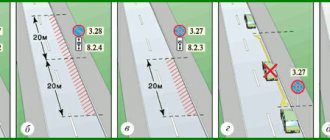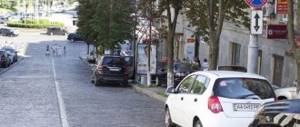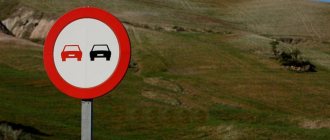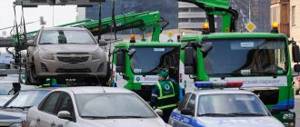Why are parking lot signs needed?
Gaps in legislation regarding the designation of parking spaces have caused all sorts of controversial situations. Paid parking, organized, in fact, illegally, has become increasingly popular. Sometimes rent for a car parked in the courtyard of an apartment building was forcibly collected from the residents of the apartments located in these buildings.
In order to suppress illegally issued parking fines, the term “parking” was established in the traffic rules. To indicate the parking lot, road sign 6.4 was identified, which previously designated a parking space. This step gave rise to new controversial situations, because the parking areas previously designated with such a sign did not correspond to the new definition of parking.
To eliminate the incidents that arose, clause 12.2 of the traffic rules was changed, the new edition of which reflected the possibility of parking a car as follows:
- parallel to the roadway:
- at an angle to the road if there is a sign indicating this type of parking.
Inaccuracies in the legal acts regulating car parking rules gave rise to unauthorized actions on the part of traffic police officers. Thus, for parking in a pocket that is not parallel to the road, the driver was fined 500 rubles. according to Art. 12.19. To systematize legal acts, the term “platform” began to be used.
Is it possible to park in a driveway pocket? In what cases is it prohibited and what is the penalty?
You need to park your car, you see a great place - on the widening adjacent to the roadway. But you can only stand there at an angle to the edge of the road - all cars stand that way. Is it possible to park in a pocket like this in 2021 and is it even allowed to stop in such a place with or without road signs and markings? In what cases is it prohibited and what is the penalty for this?
What documents reflect the basic concepts?
To determine whether a driver has violated the Traffic Rules in terms of illegal parking or to protect his interests in court, it is necessary to have an understanding of the basic concepts of parts of highways.
The following documents will help you get acquainted with the concepts:
- Traffic rules in which only “parking” is used among the terms for organizing parking, i.e. a specially designated area intended for paid or free (depending on the owner’s decision) car parking.
- GOST 32846-2014, reflecting the improvement of public roads. According to this document, a parking lot can include not only an organized site, but also an expansion of the roadway intended for:
- transport stops;
- short-term parking at monuments, service stations or other objects.
- GOST R 52289-2019. According to this document, car parking is designated using the sign 8.6.1 “Method of parking.” The presence of a sign indicating the specific method of positioning the vehicle under the sign is mandatory.
Clause 5.7.5 of the specified GOST excludes the designation of parking without such signs. Thus, a sign indicating parking and not having an additional sign indicating the method of parking (8.6.2 - 8.6.9) will be recognized as not complying with the GOST in question. Prosecution for illegal parking on the basis of such a sign will be unlawful and easily contested in court.
- SP 42.13330.2016 – set of rules for urban planning. This document reflects the concept of parking as follows: a site on the roadway or sidewalk, provided with the necessary capacity (number of cars per hour).
- SP 396.1325800.2018 - a set of rules for streets and roads running in populated areas, reflecting, among other things, the width of parking lots. According to this document:
- parking is not allowed on main roads and streets of 1st and 2nd class;
- it is allowed to organize parking on class 3 main streets and district streets in specially designated pockets;
- no restrictions are imposed on parking lots located on city or village streets. Thus, if the pocket is located on a section of a residential or town street, you can park your car without the risk of being held liable.
What does a driver face for violating parking rules?
But arguing with law enforcement officers is fraught not only with unpleasant emotions, but also with more tangible consequences that can hit the driver’s pocket well. Yes, yes, we are talking about a fine, the amount of which is clearly stated in the current Code of Administrative Violations of the Russian Federation.
And if you are guided by these legal norms, then stopping at a place where the roadway is widened that is not marked with any signs (Part 1 of Article 12.19 of the Code of Administrative Offenses of the Russian Federation) threatens the violator with a monetary penalty in the amount of 500 Russian rubles.
If the incident occurs in Moscow or St. Petersburg, the fine will be increased 5 times, regulated by part 5 of the same article.
For the same offense in a public transport stop zone, you will have to pay a thousand rubles, since this is exactly the fine provided for in part 3.1 of article 12.19.
At the same time, for residents of the current and former capital, such a prank will result in 3 thousand, which is indicated in Part 6 of Article 12.19. And here you can paraphrase the well-known phrase about “If you’re not sure, don’t overtake,” using the word “don’t park” instead of the last recommendation.
Can you park in your pocket?
Any pocket on the roadway must be marked with one of the following images:
- Yellow markings 1.17 together with signs indicating stopping places for route vehicles (5.16-5.18). Parking a car under such conditions is unacceptable;
- A “Parking” sign with a sign indicating the specific way to park the car. In such a place, the driver has all legal grounds for parking;
- "No Stopping" sign.
Sometimes, in front of a pocket that is not marked with a sign or markings, there is a 3.2 sign prohibiting stopping in the indicated place. This fact misleads drivers, because in fact the unmarked pocket is not part of the road covered by the sign. But traffic police officers often do not share this point of view and attribute the pocket to the widening of the roadway.
Many sources say that if, along with the “No Stopping” sign, a “Parking” sign is installed, then the latter will have priority. However, there are often cases in which traffic police officers draw up reports on drivers who parked a car in such a controversial place.
If the sign prohibiting stopping is also supported by the “Car Towing” sign, then in order to avoid disputes and fees for impound parking, the driver should look for a more suitable place to park the vehicle.
Is it possible to get into the pocket of the road?
The answer to this question is quite complicated, and below we will find out that the formal letter of the legislation is at odds with the practice of applying punishments.
But let’s answer the main question right away:
- if a pocket of the roadway is marked with the appropriate sign 6.4 (must be used in conjunction with a sign) and/or markings, then parking in it is permitted,
- if there are no signs and markings, then stopping on this part of the road will lead to a fine, although it is not formally prohibited.
And let’s talk about the second point in more detail!
If the parking space is not marked in any way
According to traffic regulations, the road is intended for traffic, and the territory adjacent to it is intended for parking, in which, on the contrary, through traffic is prohibited. If the pocket is not marked in any way, it is considered the same as the territory adjacent to the road and allows parking of vehicles.
Clause 12 of the traffic rules indicates the possibility of parking:
- on the side of the road located to the right of the roadway;
- on the edge of the road;
- in exceptional cases on the sidewalk in specially designated places, subject to the presence of an appropriate sign and plate.
However, pocket parking still causes many controversial situations between drivers and inspectors. To prevent such disputes, the legislator should systematize the regulatory framework on the issue under consideration.
Responsibility
Punishment for a violation committed when parking a vehicle is regulated by Article 12.19 of the Administrative Code. Its size directly depends on the type of offense committed:
- Stopping at a widened roadway that is not marked accordingly will result in a fine of 500 rubles. The first time the driver gets off with a warning. If the violation occurs on the streets of St. Petersburg or Moscow, the fine will be 5 times greater (RUB 2,500).
- Parking on a section of road designated for stopping minibuses, buses or taxis will result in a fine of 1,000 rubles for the offender. In this case, residents of Moscow and St. Petersburg will have to pay 3,000 rubles.
If the driver believes that penalties were applied to him illegally, he can appeal the decision made by the traffic police officer. To do this, you need to prepare a sufficient evidence base and learn all the rules and concepts specified in the article.
Is there a “No Stopping” sign on road pockets?
Traffic engineers today build "pockets" to ensure that parked cars do not become a hindrance to other road users. Very often on the roads you can find such pockets, which are supplemented with a “No Stopping” sign. Many people believe that this is a kind of trap for motorists - they park the car, and after a while a tow truck takes it to the impound lot. Let's figure out whether this is really a provoking factor.
In large cities, pockets on the road are usually located near office buildings, restaurants and shops. Very often they are created on the initiative of local entrepreneurs, but not the authorities - this issue is not even agreed upon with the city authorities. Of course, drivers are little concerned about the legality of such a pocket.
After some time, a sign may appear in such places indicating that stopping and parking is prohibited. This situation is often taken advantage of by traffic police officers who constantly monitor such pockets and fine drivers. The logic of the employees is always clear - if the pocket is located in the area of effect of the sign prohibiting stopping, then it really is impossible to stop the vehicle there. Supposedly, this rule applies until the cancellation sign or intersection. However, the law states that the effect of signs that prohibit stopping or parking applies only to the side of the road where they are installed. Now let’s look at what a “road” is according to the definition of traffic rules. This is a strip of land that is intended for vehicle traffic. A road includes one or more carriageways, tram tracks, a sidewalk, a shoulder and dividing lines.
Now let’s try to compare at least one item with the “pocket” - nothing comes of it. This section does not belong to the roadway, since it is not intended for the movement of vehicles, but for their parking. We conclude that you can stop in pockets, even if there are signs nearby prohibiting this. Otherwise, at this rate, employees can hold accountable any driver who is located away from the roadway. Of course, this does not apply to situations where motorists park their cars at places where public transport stops.
It is interesting that many inspectors, who are confident that they are right, issued fines to motorists. The latter, in turn, contacted the relevant authorities to challenge the punishment for the violation. The Moscow Administrative Road Inspectorate has already recorded cases when the case ended in success for the driver - decisions on offenses were canceled. However, this procedure requires a lot of time and effort, so for some it is easier to pay a fine.
Bottom line . The "pockets" are designed to ensure that motorists park their vehicles and do not interfere with other road users. Very often such areas are located within the area of the stop sign. Experts have figured out whether the driver can receive a fine if he leaves the car in such a “pocket.”










